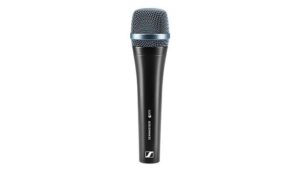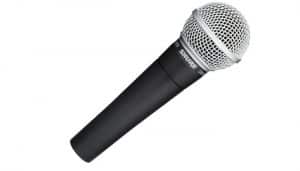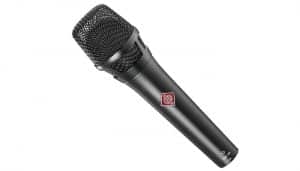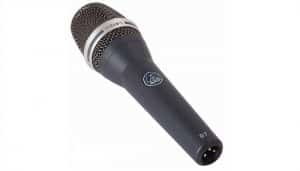The 4 Best Live Singing Microphones
A microphone is the first link, and perhaps the most important in the audio chain that transmits your voice and music to the public. With hundreds of models available, it can be a challenge knowing which microphone best suits your live sound needs. This buying guide will help you select from the 4 Best Live Singing Microphones on the market today and make an informed decision.
- Comparative Chart of the 4 Best Live Singing Microphones
- 1.- Sennheiser e935 Live Singing Microphones
- Buying Guide For the Sennheiser e935 Microphones
- 2.- Shure SM58 Live Singing Microphones
- Buying Guide for the Shure SM58 Microphones
- 3.- Neumann KMS 105 Live Singing Microphones
- Buying Guide for the Neumann KMS 105 Microphones
- 4.- AKG D7 Live Singing Microphones
- Buying Guide for the AKG D7 Microphones
- What is a Microphone?
- Why Buy Live singing Microphones?
- Important Points I Should Know Before Buying A Live Singing Microphones Of Any Make Or Model
- Which Live Singing Microphones Should I Buy?
- Conclusion
- Comparative Table of the Best Live Singing Microphones
Comparative Chart of the 4 Best Live Singing Microphones
1.- Sennheiser e935 Live Singing Microphones
 The Sennheiser e935 is a high-end cardioid microphone that employs a dual diaphragm design, which enables switchable polar patterns. In recent times, Sennheiser expanded its line of microphones for live performances with the Evolution 900 series, which included three vocal performance-oriented models: the 935 dynamic cardioid, the 945 dynamic supercardioid, and the E-965 dual-diaphragm condenser.
The Sennheiser e935 is a high-end cardioid microphone that employs a dual diaphragm design, which enables switchable polar patterns. In recent times, Sennheiser expanded its line of microphones for live performances with the Evolution 900 series, which included three vocal performance-oriented models: the 935 dynamic cardioid, the 945 dynamic supercardioid, and the E-965 dual-diaphragm condenser.
The e935 is a high-end cardioid microphone. The frequency response is impressive from 40 Hz to 20 kHz and the sensitivity is 7 mV / Pa. The maximum SPL is 142 dB without attenuation or 152 dB with pre-attenuation. The microphone is elegant in appearance, with a black body and a dark blue grille.
The grille can be unscrewed to access three switches: a sensitivity switch (10 dB pad); a low cut switch and a directivity switch (the pattern can be cardioid or supercardioid). The e935's construction is very robust, and Sennheiser apparently has a high degree of confidence in microphone durability, as it comes with a 10-year warranty. Like all other Sennheiser models, the e935 is made in Germany.
The Sennheiser e935 can handle transients very effectively when voices are powerful, and provides plenty of voice detail without becoming brittle or thin. It delivers a very natural sound, in a stable way, and its lateral rejection is highly known. This feature is highly sought after for voice activities in the field, because it receives and delivers what is really needed, which in these cases is the singer's voice. By having high lateral rejection, you ensure that ambient noise does not alter the quality of your voice.
Buying Guide For the Sennheiser e935 Microphones
The e935 is a very high-end, clear and musical microphone. Its neutral frequency response makes it suitable for a wide range of vocal applications.
Price-quality ratio
The Sennheiser e935 is considered somewhat expensive. However it is worth every penny spent. It is an excellent microphone for live voices.
Highlighting Features
Its great detail in the voice reception, and its robust design makes it a piece of great value.
Technical specifications
Where to buy the Sennheiser e935 Microphones?
We got the Sennheiser e935 Live Singing Microphones at Amazon.com
- Made for the working musician
- Shock mounted capsule with humbucking coil
- Metal construction
- Cardioid pickup pattern: Insulation from other on-stage signals
- Neodymium ferrous magnet with boron: Keeps microphone stable regardless of climate Made in Germany Metal construction: Rugged and reliable 10 Year warranty
2.- Shure SM58 Live Singing Microphones

The dynamic Shure SM58 microphone has a frequency response ranging from 50 to 15,000 Hz. There is a spherical filter built into this microphone to filter the wind. This microphone is tailor-made for vocals due to its frequency response, bass attenuation, and illuminated midrange that helps minimize the proximity effect.
On the outside, this microphone has dark gray enamel painted body with a cast metal case for that professional look. Shure's legendary quality promises durability and reliability. The microphone has a tear-resistant stand adapter that can rotate up to 180 degrees. This legendary microphone is designed for professional vocal use in studio recordings, live performances, and sound reinforcements.
It has a built-in spherical filter to minimize wind and breathing noise. The frequency response adapts to voices with a bright midrange and bass reduction. The pneumatic shock mount system also cuts off driving noises.
Buying Guide for the Shure SM58 Microphones
The Shure SM58 vocal microphone is an exceptional microphone and is the first choice for many musicians, artists and speakers. Its price is quite affordable. And since it was released, it has become the standard of what a good microphone should be.
Price-quality ratio
This is a microphone that adds a lot of value for so little money. It has a great value for the price. It is highly recommended.
Highlighting Features
The Shure SM58s have unidirectional pickup patterns (cardioids) that isolate the main sound source and decrease unwanted surround sounds, making them ideal for live situations.
Technical specifications
Where to Buy Shure SM58 Microphones?
We got these Shure SM58 Live Singing Microphones at Amazon.com
- RENDIMIENTO VOCAL EXEPCIONAL - El SM58-LCE ofrece una reproducción vocal de alta calidad, gracias a su respuesta de frecuencia adaptada y a su rango medio iluminado para voces claras y presentes.
- ESTÁNDAR DE LA INDUSTRIA - La primera opción para los artistas de todo el mundo, el micrófono dinámico vocal SM58 está listo para dar vida a cualquier actuación. Del club al estadio, Shure le cubre las espaldas.
- CLARIDAD Y CUIDADO - El patrón polar cardioide uniforme reproduce cada nota tal y como fue concebida, ofreciendo un sonido cálido y nítido una y otra vez.
- DEJE ATRÁS EL RUIDO DE FONDO - El SM58 tiene una rejilla de malla esférica y un filtro anti-pop integrado para mantener cualquier ruido no deseado fuera de la mezcla.
- SUELTA EL MICRÓFONO - La construcción duradera y el adaptador de soporte resistente a la rotura hacen del SM58 el compañero perfecto en la carretera, que se mantiene fuerte en las actuaciones más duras.
3.- Neumann KMS 105 Live Singing Microphones

The Neumann KMS 105 aims to incorporate its renowned ability to turn high-end studio microphones into a high-end microphone for vocals on stage. This microphone is designed with high acoustic resolution and a smooth frequency response to ensure the kind of sound quality normally expected in a studio and on stage.
The KMS 105 features a super-cardioid polar pattern, which makes it great for suppressing side sounds and those that originate behind the microphone, and helps to eliminate feedback on stage.
This microphone has a built-in high-pass filter to help with unwanted low-frequency sounds. The maximum sound pressure level of KMS microphones is 150 dB, making it suitable for even the loudest singers.
Although this amount of quality is never cheap, the price will certainly be out of reach for many amateur singers. Ideally, you'll also need a high-end PA system, preamp, and effects unit to get the best out of this microphone.
Buying Guide for the Neumann KMS 105 Microphones
Overall, the KMS 105 is an excellent microphone and an excellent choice for singers looking for the best vocal sound quality on stage. Neumann's vocal quality far exceeds what you would expect from the SM58. That said, in genres like Rock or Metal, where pristine vocal sound is less important, a microphone like the KMS 105 isn't necessarily a better option. Where the KMS 105 shines particularly is when used in jazz or more acoustic styles where a studio-like high-fidelity vocal sound is sought that captures all the nuances of performance.
Price-quality ratio
It's considered expensive, but it's an excellent, professional-grade microphone.
Highlighting Features
The microphone is solidly built to withstand years of road use and its grille is made of hardened steel and can be easily unscrewed if necessary to allow cleaning of the interior acoustic filter. Its high-quality sound and low self-noise level of just 18 dB, means that you can also use the microphone to record excellent sounding vocals in your home studio, as well as for live use.
Technical specifications
Where to Buy the Neumann KMS 105 Microphones?
We got the Neumann KMS 105 Live Singing Microphones in Amazon.com
- neumann sonido en el escenario
- Micrófono de condensador altamente detallados para aplicaciones exigentes en el escenario
- Robusta carcasa de metal reduce el ruido de manejo
- Incluye soporte de montaje y bolsa de nylon acolchada
4.- AKG D7 Live Singing Microphones

The AKG D7 is a microphone that meets your reference quality claim. The D7, like other AKG microphones, exhibits an attractive appearance. The die-cast zinc alloy body of the microphone tapers to the segment of the body intended for manipulation, which is reduced less drastically towards the tail end of the microphone where its XLR connector is located, surrounded by a bezel on the microphone.
Two different versions of the D7 are available. The standard D7, which has a bluish-gray and matte blue finish, and The D7 LTD, which features a bright chrome casing to "meet special aesthetic requirements," according to AKG documentation. And this is not a wrong statement, it is a beautiful microphone. In addition to these two variations of the D7, a D7 pod is available for use with AKG's WMS 4000 and WMS 4500 wireless systems.
This microphone displays amazing quality, exceptionally high gain before feedback as a result of a frequency independent super-cardioid polar pattern, better vocal sharpness resulting from a built-in high pass filter, minimized electrical interference as a result of humbucking coil, ultra-low p-pops resulting from a new interior windshield, and reduced cable manipulation and noise resulting from a mechanical-pneumatic transducer shock mount.
Buying Guide for the AKG D7 Microphones
The bottom line is that you will really like the clarity and resolution of this microphone, and it also impresses with the warmth and fullness it exhibits. The AKG D7 is a top shelf handheld microphone, and I highly recommend it for performances that require a top microphone.
Price-quality ratio
There is a good quality price relation. It is a mid-range microphone at a very affordable price.
Highlighting Features
Its built-in humbucking coil and robust design are the highlight.
Technical specifications
Where to buy the AKG D7 Microphones?
We got the AKG D7 Live Singing Microphones in Amazon.com
- Diafragma varimotion
- Patrón polar supercardioide
- Suspensión neumática
What is a Microphone?
The microphones can be considered as reverse speakers. These are devices that have the ability to translate sound vibrations into electricity in the form of electrical signals. Microphones are the necessary medium to record any type of sound, be it voices or music. If it weren't for the invention of the microphone during the 19th century, the world around us would be a quieter place. Microphones were a great invention, an invention so impressive that it led to the invention of various other devices such as television, radio, etc.
How Does A Microphone Work?
Microphones convert waveform energy of sound into electrical energy. If you place a microphone near your mouth, the words enter the microphone in the form of sound waves. When sound energy hits the diaphragm, it causes the diaphragm to vibrate. A coil of cable that is attached to the diaphragm will also move when exposed to sound waves.
The coil moves through the magnetic field created by a permanent magnet inside the microphone, causing an electric current to flow through the coil. This current or electrical energy is then transmitted to a recording device or amplifier, and then, the energy of the sound is converted into electrical energy. Thanks to the microphone, you can now record or send your voice to everyone.
Types of microphones
Microphones are mainly available in two different types, dynamic microphones and condenser microphones. Both types of microphones have different uses and applications.
Dynamic Microphones
The most common type of microphone found in live music setup is the dynamic microphone. In most dynamic microphones, a very thin and light diaphragm moves in response to changes in sound pressure. The movement of the diaphragm causes a voice coil that is suspended in a magnetic field to move, generating a small electric current.
In general, it is less expensive than condenser microphones, although very high quality dynamic microphones can be quite expensive. The dynamic microphone features a fairly robust construction and can often handle very high sound pressure levels (SPL). Due to the mechanical nature of their operation, dynamic mics are sometimes less sensitive to sound attack and may not reproduce the high-frequency "detail" that other types of microphones can produce.
Condenser microphones
Condenser microphones are famous for having an extremely flat frequency response and also for their sensitivity. The major application of these microphones is audio recording. The diaphragms of these microphones begin to vibrate as soon as they are struck by sound waves, resulting in a change in distance between the back and the faceplate that is transmitted in the form of electrical energy. In this link you can see more about condenser microphones.
Why Buy Live singing Microphones?
Different microphones are best suited for a variety of different applications. To choose the best possible microphone, you must determine what you will use it for. Are you recording in the studio, playing live, etc.? Do you need a microphone that is better for vocals or recording instruments? Once you have figured out how you are going to use your microphone, then set a budget and decide what suits your needs within that budget. Choosing the right microphone is entirely based on your requirements as an artist or engineer.
Live Singing Microphones must fulfill certain characteristics that you should look for:
When choosing the right microphone for your needs, there are a number of factors to consider. You are probably using one-way microphones in most applications because they are very good at isolating sound sources and preventing feedback. If you are using stage monitors, you may want tighter pickup patterns and consequently better gain before feedback from super-cardioid microphones. The type of instruments you're using and the sound you're looking for will tell you if you need the frequency response of a condenser microphone or a dynamic one.
Important Points I Should Know Before Buying A Live Singing Microphones Of Any Make Or Model
Some of the top singers use relatively inexpensive dynamic microphones, such as the iconic Shure SM58, instead of condenser models, because the dynamic microphone gives them a thicker, warmer sound and tends to wear out better over time. On the other hand, a delicate, choppy voices can take advantage of the high-end detail of a condenser microphone. You'll want to make sure you use a cardioid or hyper-cardioid microphone to avoid unwanted sounds and reduce feedback. You should also pay attention to the following.
Polar Cardioid or Super-cardioid Pattern
Depending on their design and construction, the microphones respond to sound coming from different directions with different degrees of sensitivity. A graph of this response is called a polar pattern. Looking at the polar pattern of a microphone will tell you how directional it is, or how well it will reject sound from certain directions. A unidirectional microphone rejects bleeding and helps prevent feedback.
In general, live singing microphones should generally be unidirectional, with a cardioid (or hyper-cardioid or super-cardioid) polar pattern. "Cardioid" refers to the heart-shaped graphic that represents this pattern. Rejects bleeding from other voices and instruments. This helps prevent unwanted sound from passing through your microphone.
Microphone technique for singing live
All voices deserve to be heard. Having your voice amplified in the speakers can be a very powerful feeling, especially when singing your favorite songs. However, it's easy not to get the full potential out of your voice when singing with a microphone. We will introduce you to the following as a microphone technique for singing live, to make the most of singing. Whether you're singing at home, at karaoke venues, parties, or on a live stage, here are our tips to make your voice heard in the best way possible.
Choose the Right Microphone
Not all microphones are created equal. Some are designed for professional level singing, while others are optimized for speech. Obviously, you can't bring your own microphone to a karaoke bar, but this will give you an idea of what you want.
Come closer
If you are singing in a karaoke club or other similar live singing situation, you are more likely to use a dynamic microphone, rather than a condenser one, which is generally used for recording or, for example, in orchestral concerts. The condenser microphone is more sensitive for picking up sounds, and this is why it can pick up voice from a distance and from its sides as well, where most dynamic microphones are optimized for varied use and support larger amounts of distortion-free sound, which is great for singing live.
With a dynamic microphone, you should get very close, like your lips brushing slightly against the microphone grille, and singing straight to the top.
Control the Distance - Control the Balance
When you sing live, you will likely vary with your voice and volume. Singing quietly in some parts, more volume in the high notes, going crazy with the chorus, and that's great since it is part of the charm in live performances. But if you keep your microphone in the same place, regardless of the volume, you will need an extremely fast audio engineer to adapt the volume so that the audience will hear it when you sing softly at low volume, and do not hurt their ears when you give your full power to the lungs.
Since we may not always have a fast-paced type of sound guy with us, it is recommended that you move your head or microphone back a bit if you are singing too loud. But be sure not to move the microphone further than a few inches away, and don't move it to the side of your head if you don't want the sound to go away.
Avoid Common Mistakes
Even though the live performance isn't supposed to be perfect in any way, there are a few simple things you can do to make your audience enjoy more. First of all, holding a microphone from its grill, or placing the grill against your hand or any other surface (for example, your chest, floor) can easily cause some unpleasant sounds, especially if the microphone amplification is very high in volume.
Also, avoid putting the microphone against a speaker as it can make the sound move in circles, producing a loud and unpleasant sound. Karaoke venues generally take this into account when planning the layout of the space, but if you're free to move around while singing or set up your own place to sing, pay attention to the location of the speakers.
Which Live Singing Microphones Should I Buy?
Choosing the best microphone to sing live is somewhat difficult since subjectivity and personal taste are very involved. We have made the selection of these four microphones, based on their quality characteristics and on professional reviews and user opinions. These four microphones are of high quality, and meet the expectations set, and may even exceed them in some cases.
You can select any of the four recommended, just adjusting your budget to what suits you best.
Conclusion
Finally, we hope our information serves you to make a satisfactory purchase. Our idea is to help you choose between so many options, filtering as best as possible and keeping the selection to these four microphones. Review them, analyze your needs, your options and of course your budget. Good luck, and enjoy your purchase.
Comparative Table of the Best Live Singing Microphones
Última actualización el 2024-07-27 / Enlaces de afiliados / Imágenes de la API para Afiliados
Si quieres conocer otros artículos parecidos a The 4 Best Live Singing Microphones puedes visitar la categoría Uses.
Leave a Reply





¡Más Contenido!